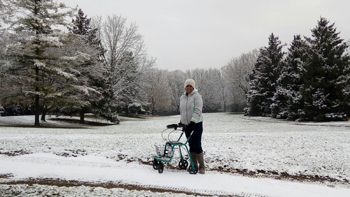Complex surgery removes rare tumour from patient’s spine

By Kelly O’Brien

Rashmi Sanjay walks through the snow only months after undergoing surgery to remove a tumour in her cervical spine, a procedure that could have left her paralyzed. (Photo courtesy of Rashmi Sanjay)
One year ago, Rashmi Sanjay came to St. Michael’s Hospital for a consultation with neurosurgeon Dr. Sunit Das.
She had recently learned she had a large tumour growing in her cervical spinal cord.
Her first neurosurgeon told her removing the tumour would leave her paralyzed from the neck down.
She and her husband were devastated by the news, and sought a second opinion from Dr. Das.
“My husband and I were overwhelmed by his genuine care,” she said. He was honest about what could happen, but we left that first meeting feeling positive and hopeful.”
Dr. Das said he told Sanjay he would perform the surgery, but could not guarantee that she would walk again.
“It’s one of those things where your heart sinks,” he said. “The placement of a tumour that high in the spinal cord makes it particularly dangerous.”
Her surgery on Sept. 27 took six hours, said Dr. Das.
“The hard thing with her tumour was two-fold: No. 1 is, it was remarkably firm—it was firm like a racquetball—and No. 2 , as I was mobilizing it away from the spinal cord, there was a point where I wasn’t able to distinguish it from the spinal cord itself,” he said.
A test during surgery revealed the tumour was a schwannoma, a common, benign tumour that usually grows outside of the spinal cord. Sanjay’s tumour was growing from her spinal cord, which has been reported in fewer than 70 cases worldwide in the last 85 years, he said.
Did you know? A schwannoma is a common, benign tumour, but usually grows outside of the spinal cord. Sanjay’s tumour was growing from her spinal cord, which has been reported in fewer than 70 cases worldwide in the last 85 years. |
“When I got the specimen back, I was shocked,” he said. “It’s exceedingly rare, and was not within my realm of expectation going in.”
Despite the unexpected, the surgery was successful. Today, Sanjay is able to walk and is doing outpatient physiotherapy treatment at Grand River Freeport Hospital in Kitchener to improve her mobility.
She said she was extremely grateful for the care she received at St. Michael’s, where her positive outlook was matched by the team in the Trauma and Neurosurgery ICU.
“To see the energy coming from the Trauma and Neurosurgery team was just fantastic,” she said. “I can’t thank them enough for all they did for me and my family.”
Dr. Das said he is glad to see the progress Sanjay has made since her surgery.
“As a neurosurgeon, the line between shepherding our patients through surgery to recovery and encountering something devastating can be so thin, so it’s so gratifying to see her now,” he said.
About St. Michael’s Hospital
St. Michael’s Hospital provides compassionate care to all who enter its doors. The hospital also provides outstanding medical education to future health care professionals in more than 29 academic disciplines. Critical care and trauma, heart disease, neurosurgery, diabetes, cancer care, care of the homeless and global health are among the Hospital’s recognized areas of expertise. Through the Keenan Research Centre and the Li Ka Shing International Healthcare Education Centre, which make up the Li Ka Shing Knowledge Institute, research and education at St. Michael’s Hospital are recognized and make an impact around the world. Founded in 1892, the hospital is fully affiliated with the University of Toronto.
